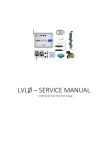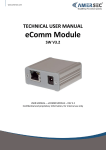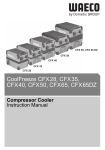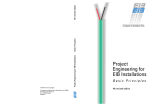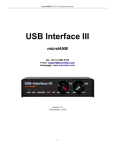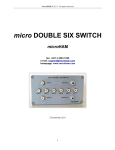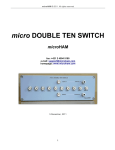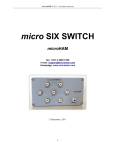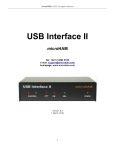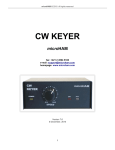Download LVLØ – KNX INTEGRATION MANUAL
Transcript
LVLØ – KNX INTEGRATION MANUAL www.lvl0.eu LVLØ – KNX INTEGRATION MANUAL Contents 1 Safety information 4 1.1 Safety instructions 4 1.2 Information for electrically skilled persons 4 Overview 5 2 3 KNX (Konnex) and LVLØ 5 3.1 Electrical connection 6 3.2 Configuration 6 3.3 KNX network address 6 Engineering with ETS 7 KNX Group Addresses 7 4 4.1 4.1.1 10/0/x Communication objects for Home screen and statistics section 8 4.1.2 10/1/x Communication objects for Dashboard section 8 4.1.3 10/2/x Communication objects for Settings and Service section 9 4.2 Example communication 10 4.2.1 1-bit output control 11 4.2.2 2-byte write and display value 11 4.2.3 2-byte display status 11 5 EC Declaration of Conformity 12 6 Notes 13 © ISA, s.r.o. 2015. All rights reserved. We reserve the right to change the specification without prior notification. Always check for new version of this document@ www.lvl0.eu KNX integration manual 1.0 | Feb-2015 | LM0003-1.0EN www.lvl0.eu 2 of 13 LVLØ – KNX INTEGRATION MANUAL 1 Safety information 1.1 Safety instruction Electrical equipment may only be installed and fitted by electrically skilled persons. The country specific regulations and the valid guidelines must be followed. Failure to observe the instructions may cause damage to the device and result in fire and other hazards. Do not connect any external voltage to the inputs. Doing so may damage the device(s). 1.2 Information for electrically skilled person DANGER! Electrical shock when live parts are touched. Electrical shocks can be fatal. Before working on the device, disconnect the power supply and cover up live parts in the working environment. Safety clearance must be guaranteed in accordance with IEC 60664--1. There must be at least 4 mm between the individual cores of the 230 V supply cable and the KNX line. © ISA, s.r.o. 2015. All rights reserved. We reserve the right to change the specification without prior notification. Always check for new version of this document@ www.lvl0.eu KNX integration manual 1.0 | Feb-2015 | LM0003-1.0EN www.lvl0.eu 3 of 13 LVLØ – KNX INTEGRATION MANUAL 2Overview You can use these instructions to integrate LVLØ to an existing KNX network and to create visualization of pool equipped with this device. LVLØ communication objects are divided into three groups. This division is based on LVLØ mobile application concept. NOTE: • • Group addresses are managed by the manufacturer. No. of group addresses and associations is 52. WARNING: • • 3 This document does not provide guidance for device commissioning. It is necessary to perform complete setup of LVLØ to ensure that LVLØ controller will work as expected. KNX and LVLØ This document contains specific information applicable to the European Tool Set (ETS) only. S-mode communications are not dealt with here. The KNX Association has its headquarters in Brussels and is an organization or association of manufacturers which maintains the KNX standard and develops it further. The KNX Association supports the trend towards the “smart home”, in which the various building services including lighting, heating, security systems and other - all communicate on the same network. Building control technology as provided by KNX is a specialized form of automated process control, dedicated to the needs of home and building applications. One premise for KNX is to furnish a radically decentralized, distributed approach; hence the term network The KNX bus enables the LVLØ to communicate with each other, i.e. to exchange process values and system data in LTE mode (LTE = Logical Tag Extended). LTE mode (LTE = Logical Tag Extended) is characterized by the assignment of zone addresses (logical tags) to create communications bindings for the exchange of process values. Device with the same zone address exchange process values with each other, one zone address being capable of transmitting the values of many data points. The KNX bus used with LVLØ is referred to as “KNX TP1”. A full-scale KNX network is a three-level structure consisting of one area line, from which 15 main lines branch off. A further 15 lines can branch off from each main line. A network consisting of main lines and lines requires area and line couplers. If no area and line couplers are used, the network is restricted to one line. Permissible bus topologies are tree, line and star topologies. These topologies can be mixed as required. However, ring topologies are not allowed. The tree topology has advantages over other topologies in cases where a large network has to be created. The bus cable comprises two twisted conductors, CE+ (red) and CE– (black). Unshielded bus cables are permitted for the KNX bus in conjunction with LVLØ device. However shielded bus cables are recommended, if high interference is anticipated. The KNX bus uses CSMA/CA (CSMA = Carrier Sense Multiple Access / CA = Collision Avoidance) to access the bus. With this method of access every bus user has equal data transmission rights. There is no communication master (in contrast to the master/slave principle). The data is exchanged directly (peer-to-peer) between bus users. © ISA, s.r.o. 2015. All rights reserved. We reserve the right to change the specification without prior notification. Always check for new version of this document@ www.lvl0.eu KNX integration manual 1.0 | Feb-2015 | LM0003-1.0EN www.lvl0.eu 4 of 13 LVLØ – KNX INTEGRATION MANUAL 3.1 Electrical connection To enable KNX on LVLØ, connect a Twisted Pair cable which fulfils the KNX requirements (e.g. YCYM 2×2×0.8 or J-Y(St)Y 2×2×0.8 in TP1 design) to the KNX bus connector. When installing a standard cable, the following conditions apply: + (plus) – Red wire - (GND) – Black wire For detailed specification refer to SERVICE MANUAL. NOTE: • Insulated wire cores of sheathed mains cables and KNX TP1 bus cables may be installed next to each other without any clearance space. A minimum clearance space of 4 mm must be observed between the insulated wire cores of KNX TP1 bus cables and those of sheathed mains cables. Alternatively, the wire cores must be provided with an equivalent insulation, such as a spacer or insulation sleeving (DIN VDE 0110-1, Basic insulation). This also applies to wire cores of other cables that are not part of SELV/PELV circuits. • Terminating resistor is not required. 3.2Configuration This application offers a wide range of setting options in order to execute numerous functions with a KNX pushbutton and controlled KNX devices like touch panels, etc. Or use pool functions in KNX scenes. You will find an overview of all the functions, parameters and the related adjustable values in the “Group addresses parameters and settings „section. All 1-bit writable communication objects need to be triggered by 1 bit pulse edge function (send telegram 1 following by 0). If pulse edge “1” / ”0” is detected at the input communication object, the output reacts to it immediately by changing current state and by sending a status telegram. 3.3 KNX network address The network address for a full-scale KNX network consists of the area, line and device address. It reflects the exact position of a bus device in the overall network and is unique within the network. NOTE: The LVLØ Ultimate Pool Controller bus device is factory-set with the KNX defined individual address 1.1.222 and can be changed only via ISA remote support. Please make sure this address is not used in KNX network. ETS software used for LVLØ is present by KNX Bus Access and Object Server in ETS. © ISA, s.r.o. 2015. All rights reserved. We reserve the right to change the specification without prior notification. Always check for new version of this document@ www.lvl0.eu KNX integration manual 1.0 | Feb-2015 | LM0003-1.0EN www.lvl0.eu 5 of 13 LVLØ – KNX INTEGRATION MANUAL 4 Engineering with ETS 4.1 KNX Group Addresses Communication between devices in an installation is carried out via group addresses. The group addresses are already assigned to the group objects. When using the ETS engineering tool, e.g. in systems with third-party devices, the ETS project database of LVLØ device must be imported into ETS. Selected data points of the LVLØ device can communicate also in S-Mode. You can download ETS files from www.lvl0.eu/download/. NOTE: Pay special attention to the following design when engineering with ETS: • Fixed group addresses are defined in the KNX standard for all system functions. • Group address are set in the LVLØ bus devices before they leave the factory. • Main group 10, middle group 0 is used for LVLØ application Home screen functions. Contains all major functions and information’s to operate pool equipment like light, cover, auxiliaries and read measured values of water quality and temperature. • Main group 10, middle group 1 is used for LVLØ application Dashboard features. Contains all major information’s about condition of pool and pool equipment. Current state of circuit breakers, sensors, buffer tank, etc. • Main group 10, middle group 2 is used for LVLØ application Setting functions. Contains all major functions to control filtration, heating, cooling details about current LVLØ and pool conditions. Status of circuit breakers, pump and valves status, sensor alerts etc. © ISA, s.r.o. 2015. All rights reserved. We reserve the right to change the specification without prior notification. Always check for new version of this document@ www.lvl0.eu KNX integration manual 1.0 | Feb-2015 | LM0003-1.0EN www.lvl0.eu 6 of 13 LVLØ – KNX INTEGRATION MANUAL 4.1.1 10/0/x Communication objects for Home screen and statistics section Group Address Data Point Name Data Point Type Description 10/0/0 LVL0 Water Temperature Output °C display of value EIS5 2 Byte R 9.001 Display actual water temperature. Floating value (°C), cyclically send to bus. 10/0/1 LVL0 Outside temperature Input °C control EIS5 2 Byte W 9.001 Control outside temperature from KNX Floating value (°C). NOTE: Setting via LVLØ mobile app must Settings>Service>HEATING>outside temperature source is set to “KNX” option. 10/0/2 LVL0 Outside Temperature Output °C display of value EIS5 2 Byte R 9.001 Display actual outside temperature. Floating value (°C), cyclically send to bus. 10/0/3 LVL0 Light Control (Send 1/0) control pulse edge 1/0 1 bit W 1.001 Actuator to control “LIGHT” output. Toggle current output status when pulse edge telegram (0/1) will be received on this input. Status feedback will be send when output changes state. 10/0/4 LVL0 Light Status Feedback (1=On, 0=Off ) display of status 1 bit R 1.001 Status feedback of “LIGHT” output. 10/0/5 LVL0 Pool Cover Control - Open (Send 1/0) control pulse edge 1/0 1 bit W 1.001 Actuator to control “POOL COVER” output. Pool cover will open when pulse edge (0/1) telegram will be received on this input. 10/0/6 LVL0 Pool Cover Control - Close (Send 1/0) control pulse edge 1/0 1 bit W 1.001 Actuator to control “POOL COVER” output. Pool cover will close when pulse edge (0/1) telegram will be received on this input. 10/0/7 LVL0 Pool Cover Status Feedback (1=Open, 0=Closed) display of status 1 bit R 1.001 Status feedback of “POOL COVER” output is send to bus when the output change state. Feedback is send cyclically to bus every 600s. 10/0/8 LVL0 AUX1 Control (Send 1/0) control pulse edge 1/0 1 bit W 1.001 Actuator to control “AUX1” output. Toggle current output status when pulse edge telegram (0/1) will be received on this input. Status feedback will be send when output changes state. 10/0/9 LVL0 AUX1 Status Feedback (1=On, 0=Off ) display of status 1 bit R 1.001 Status feedback of "AUX1" output. 10/0/10 LVL0 AUX2 Control (Send 1/0) control pulse edge 1/0 1 bit W 1.001 Actuator to control "AUX2" output. Toggle current output status when pulse edge telegram (0/1) will be received on this input. Status feedback will be send when output changes state. 10/0/11 LVL0 AUX2 Status Feedback (1=On, 0=Off ) display of status 1 bit R 1.001 Status feedback of "AUX2" output. 10/0/12 LVL0 Current Actual pH Output display of value EIS5 2 Byte R 9.* Display actual pH value. Floating value is send to bus on change or cyclically based on parameter 10/2/15. 10/0/13 LVL0 Current Actual Redox Output mV display of value EIS5 2 Byte R 9.020 Display actual Redox/ORP value in mV (-2000 +2000). Value is send to bus on change or cyclically based on parameter 10/2/15. 10/0/14 LVL0 Current Actual Free Chlorine Output mg/l display of value EIS5 2 Byte R 9.* Display actual CLF (Free chlorine) value in mg/l (ppm). Floating value is send to bus on change or cyclically based on parameter 10/2/15. 10/0/15 LVL0 Current External System Temperature Output °C display of value EIS5 2 Byte R 9.001 Display actual temperature of external heating/cooling system. Floating value (°C) is cyclically send to bus. © ISA, s.r.o. 2015. All rights reserved. We reserve the right to change the specification without prior notification. Always check for new version of this document@ www.lvl0.eu KNX integration manual 1.0 | Feb-2015 | LM0003-1.0EN www.lvl0.eu 7 of 13 LVLØ – KNX INTEGRATION MANUAL 4.1.2 10/1/x Communication objects for Dashboard section Group Address 10/1/0 10/1/1 10/1/2 10/1/3 Data Point Name LVL0 Service Required Status Feedback (1=Required, 0=OK) LVL0 Service Area Status Feedback (0=OK, 1,2,4=Err) LVL0 Circuit Breakers Status Feedback (0=OK, 1,2,4=Err) LVL0 Water Treatment Status Feedback 10/1/4 LVL0 Pump and Valves Status Feedback 10/1/5 LVL0 Buffer Tank Max.Make Up Time Status Feedback (1=ERR, 0=OK) 10/1/6 10/1/7 10/1/8 10/1/9 LVL0 Buffer Tank Max.Make Up Time Reset (Send 1/0) LVL0 Buffer Tank Water Level Status Feedback LVL0 Buffer Tank Safety Status Feedback LVL0 Sensors Status Feedback Data Point Type display of status 1 bit display of value EIS5 2 Byte display of value EIS5 2 Byte display of value EIS5 2 Byte Description R R R R 1.001 Summarized status feedback object to display if service intervention on pool is required. Telegram is send cyclically to bus every 600s. 7.* Summarized status feedback object to display service code in case of service is required on pool. Telegram with code is send to bus cyclically every 600s. Code explanation: 1 - water quality long-term (OK/ERR) 2 - technology (OK/ERR) 4 - service intervals (OK/ERR) 7.* Summarized status feedback object to display exact service code in case of Circuit breakers failure. Telegram with code is send to bus cyclically every 600s. Code explanation: 1 - dosing breaker failure (OK/ERR) 2 - filtration breaker failure (OK/ERR) 4 - additional technology breaker failure (OK/ERR) 7.* Summarized status feedback object to display exact service code in case of water treatment issues. Telegram with code is send to bus cyclically every 600s. Code explanation: 1 - pH (OK/ERR) 2 - ORP/CLF (OK/ERR) 4 - chemical stocks (OK/ERR) 8 - electrodes (OK/ERR) display of value EIS9 2 Byte R 7.* Display actual status of outputs for “DOSING PUMPS 1 - 4”, “FILTRATION”, “3 WAY VALVE” and “MAKE UP WATER VALVE”. Summarized status telegram is send to bus on change and cyclically every 600s. Code explanation: 1 - filtration pump (ACTIVE/INACTIVE) 2 - dosing pump 1 (ACTIVE/INACTIVE) 4 - dosing pump 2 (ACTIVE/INACTIVE) 8 - dosing pump 3 (ACTIVE/INACTIVE) 16 - dosing pump 4 (ACTIVE/INACTIVE) 32 - heating valve (OPEN/CLOSE) 64 - make up water (OPEN/CLOSE) display of status 1 bit R 1.005 Status to display issue with filling valve. If max. Make up water safety time is reached, alarm telegram is triggered. Telegram is send cyclically to the bus every 600s. 1.001 Actuator to reset, confirm “Max. Make up time” issue. When pulse edge (0/1) telegram will be received on this input, make up water valve will be again enabled after reaching max. Make up time set by LVLØ mobile application. Counter of make-up water duration will be reset to 0. 7.* Display actual water level in buffer tank, based on setting in LVLØ mobile application. H1 is on top of the tank, H4 represent the lowest level. Telegram with code is send to bus cyclically every 600s. Exact status codes: 1 - buffer tank (actual utilization) - H1 2 - buffer tank (actual utilization) - H2 4 - buffer tank (actual utilization) - H3 8 - buffer tank (actual utilization) - H4 8.* Display safety messages when processing water in buffer tank. Telegram with code is send to bus cyclically every 600s. Message codes: 1 - dry run protection (ACTIVE/INACTIVE) 2 - forced pumping (ACTIVE/INACTIVE) 4 - make up water (ACTIVE/INACTIVE) 8.* Summarized status feedback object to display sensors status feedback messages. Telegram with code is send to bus cyclically every 600s. Code explanation: 1 - water temperature sensor (OK/ERR) 2 - outside temperature sensor (OK/ERR) 4 - ext. system temperature sensor (OK/ERR) 8 - pH electrode (OK/ERR) 16 - ORP electrode (OK/ERR) control pulse edge 1/0 display of value EIS5 display of value EIS9 display of value EIS5 1 bit 2 Byte 2 Byte 2 Byte © ISA, s.r.o. 2015. All rights reserved. We reserve the right to change the specification without prior notification. Always check for new version of this document@ www.lvl0.eu KNX integration manual 1.0 | Feb-2015 | LM0003-1.0EN W R R R www.lvl0.eu 8 of 13 LVLØ – KNX INTEGRATION MANUAL Group Address Data Point Name Data Point Type Description 10/1/10 LVL0 Regular Service in Day Status Feedback display of value EIS9 4 Byte R 14.* Display days until next regular service, set via LVLØ mobile app. Telegram with value cyclically send to bus every 600s. 10/1/11 LVL0 pH Electrode Service in Day Status Feedback display of value EIS9 4 Byte R 14.* Display days until next service on pH electrode (calibration, replacement), set via LVLØ mobile app. Telegram with value cyclically send to bus every 600s. 10/1/12 LVL0 Redox Electrode Service in Day Status Feedback display of value EIS9 4 Byte R 14.* Display days until next service on Redox electrode (calibration, replacement), set via LVLØ mobile app. Telegram with value cyclically send to bus every 600s. 10/1/13 LVL0 CLF Electrode Service in Day Status Feedback display of value EIS9 4 Byte R 14.* Display days until next service on Free chlorine electrode (calibration, replacement), set via LVLØ mobile app. Telegram with value cyclically send to bus every 600s. 10/1/14 LVL0 UV Lamp Service in Hours Status Feedback display of value EIS9 4 Byte R 14.* Display hours until UV Lamp replacement, set via LVLØ mobile app. Telegram with value cyclically send to bus every 600s. 10/1/15 LVL0 Ozone Generator Service in Day Status Feedback display of value EIS9 4 Byte R 14.* Display days until next service on ozone generator, set via LVLØ mobile app. Telegram with value cyclically send to bus every 600s. 10/1/16 LVL0 Salt Chlorine Gen. Service in Day Status Feedback display of value EIS9 4 Byte R 14.* Display days until next service of salt chlorine generator, set via LVLØ mobile app. Telegram with value cyclically send to bus every 600s. 10/1/17 LVL0 Filtration Service in Day Status Feedback display of value EIS9 4 Byte R 14.* Display days until next service on filtration unit (filter), set via LVLØ mobile app. Telegram with value cyclically send to bus every 600s. 10/1/18 LVL0 Heat Pump Service in Day Status Feedback display of value EIS9 4 Byte R 14.* Display days until next service on heat pump or heat exchanger, set via LVLØ mobile app. Telegram with value cyclically send to bus every 600s. 10/1/19 LVL0 Salt Chlorine Generator Status Feedback display of status 1 bit R 1.005 Status to display “SALT GENERATOR” output state. Telegram is send cyclically to the bus every 600s. 4.1.3 10/2/x Communication objects for Settings and Service section Group Address Data Point Name 10/2/0 LVL0 Filtration Pump Control (Send 1/0) 10/2/1 LVL0 Filtration Pump Status Feedback (1=On, 0=Off ) Data Point Type Description control pulse edge 1/0 1 bit W 1.001 Actuator to control “FILTRATION” output. Toggle current output state when pulse edge telegram (0/1) will be received on this input. Status feedback will be send when output changes state. display of status 1 bit R 1.001 Status feedback of “FILTRATION” output. control pulse edge 1/0 1 bit W 1.001 Actuator to control filter cleanup/backwash process. Detailed backwash process can be set via service menu of the LVLØ mobile app. To initiate/start backwash pulse edge telegram (0/1) need to be send to this input. Status feedback will be send when the process is running. LVL0 Filter Cleanup Status Feedback (1=On, 0=Off ) display of status 1 bit R 1.001 Status feedback of the filter cleanup/backwash process. 10/2/4 LVL0 Water Temperature Setpoint Input °C control EIS5 2 Byte W 9.001 Control water temperature set point from KNX. Floating value (°C) will adjust desired water temperature. 10/2/5 LVL0 Water Temperature Setpoint Output display of value EIS5 2 Byte R 9.001 Display actual water temperature set point value. Floating value (°C) is cyclically send to bus every 600s. 10/2/6 LVL0 Water Temperature Setpoint Hysteresis Input °C control EIS5 2 Byte W 9.001 Floating value (°C). Control hysteresis of the 2-step heating/cooling controller for water temperature from KNX. Setting rule: Small hysteresis leads to small fluctuations, but frequent switching. Large hysteresis leads to big fluctuations, but infrequent switching. 10/2/7 LVL0 Water Temperature Setpoint Hysteresis Output °C display of value EIS5 2 Byte R 9.001 Display actual set point hysteresis temperature. Floating value (°C) is cyclically send to bus every 600s. 10/2/2 LVL0 Filter Cleanup Control (Send 1/0) 10/2/3 © ISA, s.r.o. 2015. All rights reserved. We reserve the right to change the specification without prior notification. Always check for new version of this document@ www.lvl0.eu KNX integration manual 1.0 | Feb-2015 | LM0003-1.0EN www.lvl0.eu 9 of 13 LVLØ – KNX INTEGRATION MANUAL Group Address Data Point Name 10/2/8 LVL0 Cooling Enable Control (Send 1/0) 10/2/9 LVL0 Cooling Status Feedback (0=Disabled;1=Enabled) 10/2/10 10/2/11 10/2/12 LVL0 6-Way Valve Status Feedback 1 bit W 1.001 Actuator to enable/disable water cooling feature. Toggle current output status when pulse edge telegram (0/1) will be received on this input. Status feedback will be send when output changes state. display of status 1 bit R 1.001 Status feedback of the cooling feature output. control EIS5 10/2/14 LVL0 Heating Valve Control (Send 1/0) 10/2/15 LVL0 Minimum Sensors Sending Interval Input (s) 2 Byte display of value EIS5 LVL0 Pool Mode Control Input LVL0 Pool Mode Control Output Description control pulse edge 1/0 LVL0 6-Way Valve Control Input 10/2/13 4.2 Data Point Type 2 Byte control EIS5 2 Byte display of value EIS5 2 Byte control pulse edge 1/0 1 bit control of value EIS5 2 Byte W R W R W 7.* Control input to switch position of “6 WAY VALVE” outputs. To switch position, send telegram with number of desired valve position: 1 - position closed 2 - position backwash 3 - position recirculate 4 - position waste 5 - position filter 6 - position rinse Actual position will be send via status feedback object. 7.* Display actual position of “6 WAY VALVE” output. Telegram with position is send on change and cyclically every 600s. Position values: 1 - position closed 2 - position backwash 3 - position recirculate 4 - position waste 5 - position filter 6 - position rinse 7.* Control actual pool mode. To switch mode, send telegram with number of desired mode: 1 - in use 2 - closed 3 - winter NOTE: service mode can be controlled only from device LCD panel 7.* Display current pool mode via status feedback value. Telegram with current mode number is send to bus on change and cyclically every 600s. 1 - pool in use 2 - pool closed 3 - pool winter mode 4 - pool service mode 1.001 Actuator to control “3 WAY VALVE” output. Toggle current output state (open/closed) when pulse edge telegram (0/1) will be received on this input. Use this input to control heating valve from master heating system. 7.005 Control interval for sending measured values (temperatures, CLF, pH, ORP) to bus. Applies only to sensors. Example communication © ISA, s.r.o. 2014. All rights reserved. We reserve the right to change the specification without prior notification. Always check for new version of this document@ www.lvl0.eu KNX integration manual 1.0 | Feb-2015 | LM0003-1.0EN 10 of 13 www.lvl0.eu LVLØ – KNX INTEGRATION MANUAL 4.2.1 1-bit output control To trigger LVLØ 1-bit output via KNX bus a toggle from 1 to 0 need to be send to the bus. Example bus communication to control the output: 10/0/3 Write 1-bit 1 =send 1 to bus 10/0/3 Write 1-bit 0 =send 0 to bus 10/0/4 Receive 1-bit 1 = receive “ON” status of the output 10/0/3 Write 1-bit 1 =send 1 to bus 10/0/3 Write 1-bit 0 =send 0 to bus 10/0/4 Receive 1-bit 0 = receive “OFF” status of the output 4.2.2 2-byte write and display value Change pool mode telegram with status feedback. 4.2.3 2-byte display status Display water temperature. © ISA, s.r.o. 2015. All rights reserved. We reserve the right to change the specification without prior notification. Always check for new version of this document@ www.lvl0.eu KNX integration manual 1.0 | Feb-2015 | LM0003-1.0EN 11 of 13 www.lvl0.eu LVLØ – KNX INTEGRATION MANUAL 1 EC Declaration of Conformity © ISA, s.r.o. 2015. All rights reserved. We reserve the right to change the specification without prior notification. Always check for new version of this document@ www.lvl0.eu KNX integration manual 1.0 | Feb-2015 | LM0003-1.0EN 12 of 13 www.lvl0.eu ISA, s. r. o., Pluhova 14 900 28 Ivanka pri Dunaji Slovak Republic http://www.lvl0.eu [email protected] Phone numbers: Slovakia/ global +421 2 3819 9150 France 0805 080 060 0977 550 060 Germany 0800 723 509 0 Spain 900 838 880 518 880 060













